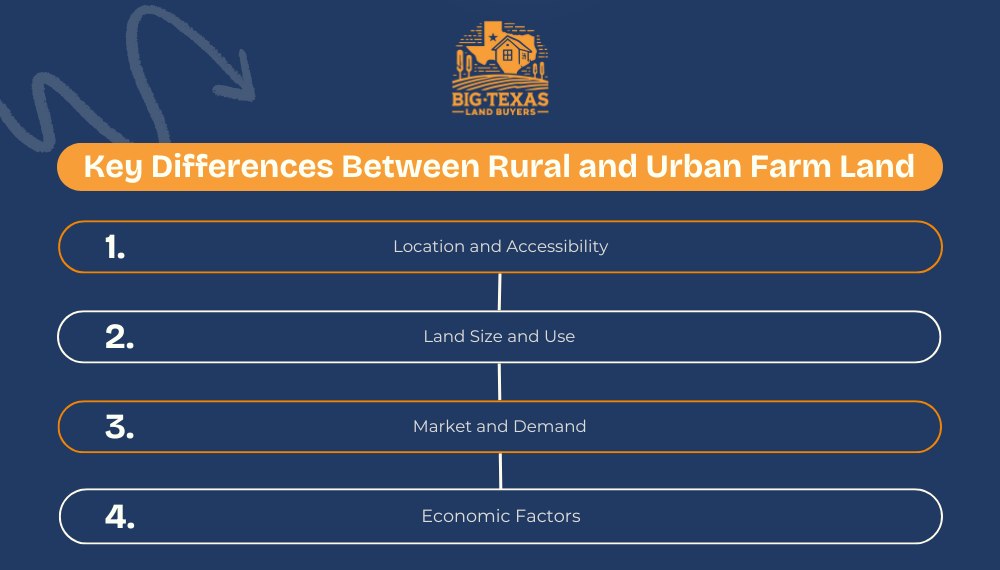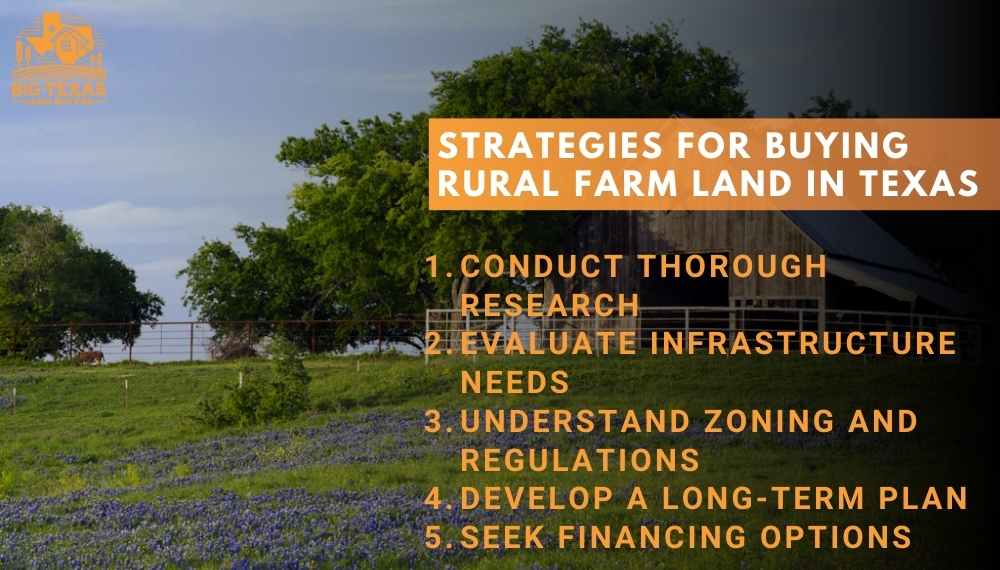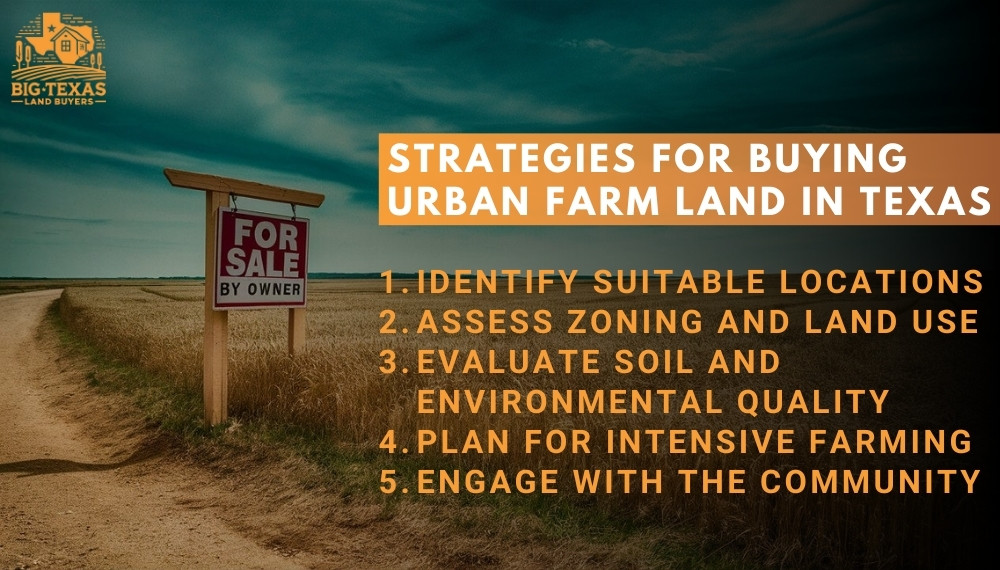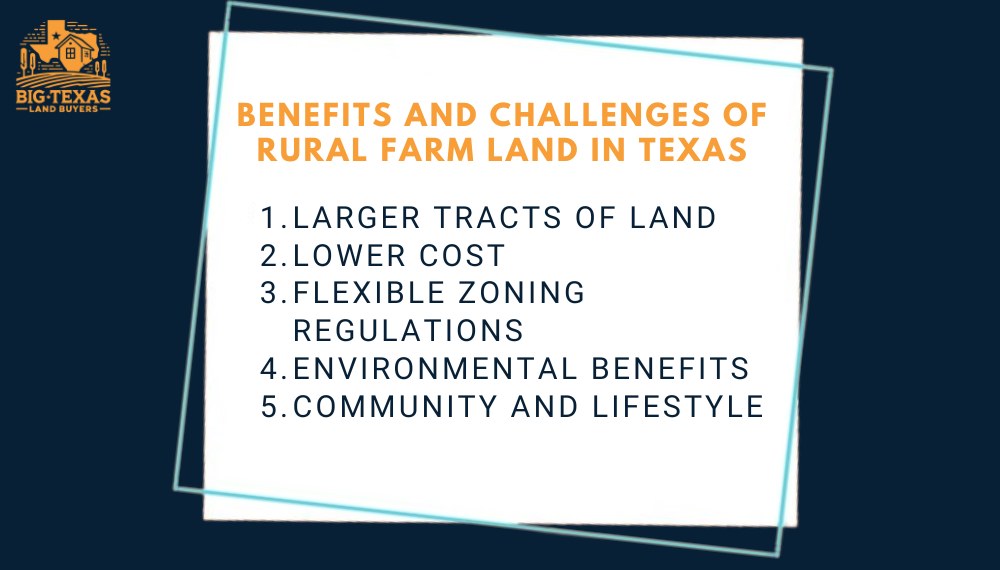When considering purchasing farm land for sale in Texas, it’s essential to understand the key differences between Rural vs Urban Farm Land for Sale in Texas. Each type of land presents unique opportunities and challenges that can significantly impact your investment. This comprehensive guide explores these differences and offers strategies to help you make an informed decision.
Key Differences Rural vs Urban Farm Land for Sale in Texas

Location and Accessibility
Rural Farm Land:
- Location: Typically situated far from major cities and towns, offering vast, open spaces.
- Accessibility: May have limited access to major highways, roads, and public transportation. Often requires travel on unpaved roads.
- Infrastructure: Basic infrastructure; utilities like water, electricity, and internet may be less reliable or require significant investment to install.
Urban Farm Land:
- Location: Located within or near city limits, close to residential and commercial areas.
- Accessibility: Excellent access to major roads, highways, and public transportation. Infrastructure like water, electricity, and internet are readily available.
- Infrastructure: Well-developed infrastructure, reducing the need for additional investment in utilities.
Land Size and Use
Rural Farm Land:
- Size: Generally larger tracts of land, offering more space for extensive farming operations.
- Use: Ideal for large-scale agriculture, livestock farming, and recreational activities like hunting and fishing. Suitable for diversified farming operations.
- Flexibility: Fewer zoning restrictions, allowing for a wide range of agricultural uses.
Urban Farm Land:
- Size: Smaller parcels of land, often limited by urban development and zoning laws.
- Use: Suitable for urban farming, community gardens, and small-scale specialty farming (e.g., organic vegetables, herbs, and flowers). Limited space for large-scale operations.
- Flexibility: Stricter zoning regulations and higher property taxes can restrict the types of farming activities permitted.
Market and Demand
Rural Farm Land:
- Market: Demand is typically lower, resulting in lower land prices. However, there may be strong interest from agricultural investors and large-scale farming operations.
- Sales Cycle: Longer sales cycle due to lower demand and remote location.
- Potential Buyers: Farmers, ranchers, recreational land buyers, and conservationists.
Urban Farm Land:
- Market: High demand due to proximity to urban centers, resulting in higher land prices.
- Sales Cycle: Shorter sales cycle as urban land attracts more potential buyers, including developers and investors.
- Potential Buyers: Urban farmers, real estate developers, and investors looking for redevelopment opportunities.
Economic Factors
Rural Farm Land:
- Cost: Generally lower land prices and property taxes compared to urban land.
- Investment: Requires significant investment in infrastructure, equipment, and transportation.
- Revenue: Potential for higher revenue through large-scale agricultural production and diverse farming activities.
Urban Farm Land:
- Cost: Higher land prices and property taxes due to urban location.
- Investment: Lower initial investment in infrastructure but higher costs for land acquisition.
- Revenue: Potential for high revenue from specialty farming, direct-to-consumer sales, and agritourism.
Strategies for Buying Rural Farm Land in Texas

1. Conduct Thorough Research
Understand the local market, including land prices, demand, and the types of crops or livestock that thrive in the area. Visit the land in person to assess its suitability for your farming needs.
2. Evaluate Infrastructure Needs
Assess the availability and condition of essential infrastructure, such as roads, water supply, electricity, and internet. Factor in the cost of upgrading or installing necessary utilities.
3. Understand Zoning and Regulations
Research local zoning laws and regulations to ensure your intended farming activities are permitted. Consider consulting with a local attorney or real estate agent familiar with agricultural land.
4. Develop a Long-Term Plan
Create a detailed business plan outlining your farming goals, expected costs, and revenue projections. Include plans for land management, crop rotation, and sustainable farming practices.
5. Seek Financing Options
Explore financing options, such as agricultural loans, grants, and subsidies, to support your land purchase and farming operations. Work with lenders experienced in agricultural financing.
Strategies for Buying Urban Farm Land in Texas

1. Identify Suitable Locations
Look for urban areas with a growing interest in local food production and community-supported agriculture (CSA). Consider proximity to farmers’ markets, restaurants, and consumers.
2. Assess Zoning and Land Use
Understand the zoning regulations and land use restrictions in the area. Ensure the land is zoned for agricultural use or explore the possibility of obtaining a zoning variance.
3. Evaluate Soil and Environmental Quality
Conduct soil tests and environmental assessments to determine the land’s suitability for urban farming. Consider the potential for contamination and the need for soil remediation.
4. Plan for Intensive Farming
Develop a plan for intensive farming techniques, such as vertical farming, hydroponics, and raised bed gardening, to maximize productivity on limited land.
5. Engage with the Community
Build relationships with local community organizations, schools, and businesses to create support for your urban farming project. Consider offering educational programs, workshops, and volunteer opportunities.
Benefits and Challenges of Rural Farm Land in Texas

Benefits of Rural Farm Land
- Larger Tracts of Land: Rural farm land in Texas typically offers larger parcels compared to urban areas. This vast space provides ample opportunities for extensive agricultural operations, livestock farming, and recreational activities such as hunting and fishing. The ability to purchase large tracts of land is especially advantageous for those looking to establish diversified farming operations, which can include a mix of crops, livestock, and even forestry.
- Lower Cost: One of the most significant advantages of rural farm land for sale in Texas is the lower cost per acre compared to urban areas. This affordability allows investors to acquire more land for their money, providing greater potential for expansion and large-scale farming. Additionally, lower property taxes in rural areas reduce the ongoing costs of land ownership.
- Flexible Zoning Regulations: Rural areas often have fewer zoning restrictions, offering more flexibility for various agricultural uses. This means landowners can engage in a wide range of farming activities without needing to navigate complex urban zoning laws. This flexibility is ideal for innovative or non-traditional farming practices, such as agroforestry or permaculture.
- Environmental Benefits: Rural farm land often boasts healthier ecosystems with diverse plant and animal life. These areas typically have less pollution and lower risk of soil contamination compared to urban environments. This makes rural land ideal for organic farming and other sustainable agricultural practices that rely on high-quality soil and water resources.
- Community and Lifestyle: Living and working in a rural area offers a unique lifestyle with a strong sense of community. Rural residents often enjoy a slower pace of life, closer connections with neighbors, and a greater sense of tranquility and privacy. This lifestyle can be appealing to those looking to escape the hustle and bustle of urban life.
Challenges of Rural Farm Land
- Limited Infrastructure: One of the primary challenges of rural farm land for sale in Texas is the limited infrastructure. Rural areas may lack access to essential services such as reliable electricity, water supply, and high-speed internet. These deficiencies can increase the cost and complexity of establishing and maintaining farming operations.
- Isolation: Rural farm land is often located far from major cities and towns, which can lead to feelings of isolation. This distance from urban centers can also make it difficult to access markets, suppliers, and services, potentially increasing transportation costs and logistics challenges for farmers.
- Accessibility Issues: Rural land may have limited access to well-maintained roads and transportation networks. Unpaved or poorly maintained roads can make it challenging to transport goods, equipment, and personnel to and from the farm. This can hinder the efficiency of farming operations and increase wear and tear on vehicles.
- Lower Demand and Longer Sales Cycles: Selling rural farm land can be more challenging due to lower demand and longer sales cycles. The remote location and larger size of rural properties can limit the pool of potential buyers, making it harder to sell the land quickly and at a desirable price.
- Environmental Risks: While rural areas offer many environmental benefits, they can also present challenges such as exposure to extreme weather conditions, including droughts, floods, and storms. These environmental risks can impact crop yields, livestock health, and overall farm productivity.
Benefits and Challenges of Urban Farm Land in Texas
Benefits of Urban Farm Land
- Proximity to Markets: Urban farm land for sale in Texas benefits from its close proximity to major markets, including consumers, restaurants, and retailers. This accessibility allows farmers to sell their produce directly to local customers, reducing transportation costs and increasing freshness and quality.
- Developed Infrastructure: Urban areas typically have well-developed infrastructure, including reliable access to water, electricity, and high-speed internet. This infrastructure supports efficient farming operations and reduces the need for significant upfront investment in utilities.
- High Demand and Shorter Sales Cycles: The demand for urban farm land is generally higher than for rural land, leading to shorter sales cycles. The proximity to urban centers attracts a diverse range of potential buyers, including urban farmers, real estate developers, and investors interested in redevelopment opportunities.
- Community Engagement: Urban farming initiatives often receive strong support from local communities, schools, and organizations. Engaging with the community through educational programs, workshops, and volunteer opportunities can foster a sense of collaboration and enhance the social impact of urban farming projects.
- Sustainable and Innovative Practices: Urban farm land provides opportunities for implementing sustainable and innovative farming practices, such as vertical farming, hydroponics, and rooftop gardens. These practices maximize productivity on limited land and contribute to the urban food system’s sustainability.
Conclusion
Whether you are considering rural or urban farm land for sale in Texas, understanding the key differences and implementing effective strategies is crucial for a successful investment. Rural farm land offers vast spaces and lower costs, ideal for large-scale operations, while urban farm land provides accessibility and higher market demand, suitable for specialty farming. By conducting thorough research, evaluating infrastructure needs, understanding zoning regulations, and developing long-term plans, you can make an informed decision and capitalize on the opportunities each type of land offers. Investing in farm land for sale in Texas can be a rewarding venture with the right approach and strategic planning.
Follow us:

